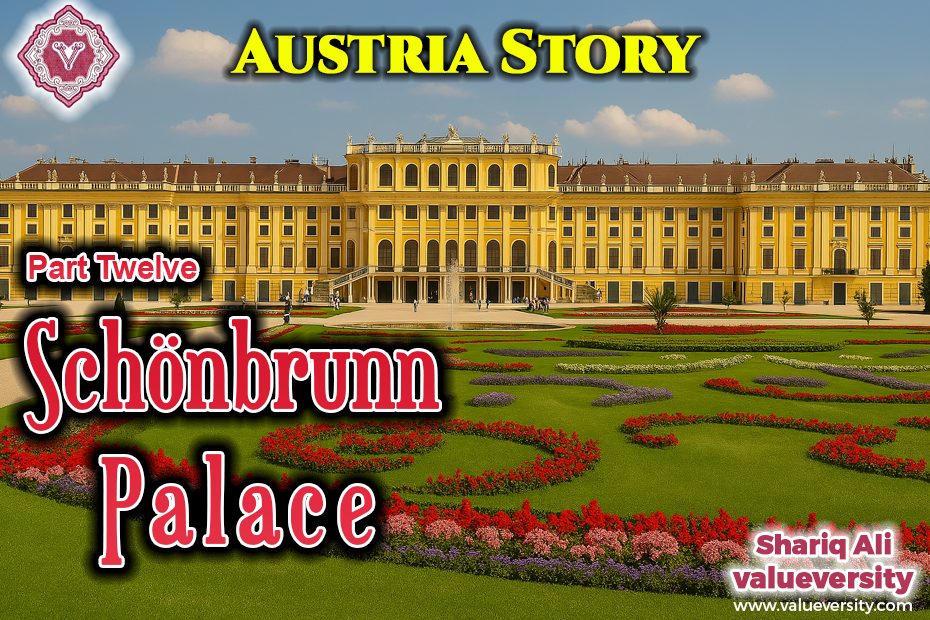Episode 12
by Shariq Ali
Valueversity
We woke up late in the morning. After shaving, I decided to walk to the nearby grocery store, while Mona stayed in the room, busy with some important phone calls.
It’s my habit to taste the local fruits and vegetables whenever I visit a new country. The apples in Austria turned out to be far more wholesome and flavorful than those in the UK. The apricots were also exceptionally delicious. Along with apples and apricots, I picked up some cherries, dark chocolate, and other essentials from the store.
Back in the room, we enjoyed a hearty breakfast accompanied by Austrian tea. We had reserved the morning for our visit to Schönbrunn Palace. Interestingly, our hotel used to be the residence of a royal courtier and was just about two hundred yards from the palace.
This palace is one of Vienna’s most famous tourist attractions.
After stepping out of the hotel and crossing a busy main road, we walked a short distance and saw a large iron gate leading into the palace gardens. This was the side entrance. We presented our pre-purchased tickets and entered the gardens.
The garden was lined on both sides with old yet healthy trees. Beneath their shade were colorful flower beds, fountains, and benches along the walkways. Some people were enjoying carriage rides, while others were walking and taking in the serene atmosphere. We, too, sat on a bench and quietly observed the scene.
After a pleasant half-mile walk, we reached the main building, which radiated historical grandeur.
Austria, often referred to as the heart of Europe, was once considered the last stronghold against the Ottoman Empire. In 1529, Sultan Suleiman the Magnificent laid siege to Vienna, but due to weather and local resistance, he had to retreat. Following this, power in Austria shifted to the Habsburg dynasty, who transformed Vienna into a hub of European culture, art, and politics.
Schönbrunn Palace, a symbol of Habsburg wealth and power, was built in the 17th century. It’s not merely a palace but a reflection of governance, architectural taste, and royal lifestyle.
The palace’s decoration, gardens, and halls silently narrate Austria’s royal history. A bit further ahead, we arrived at the main entrance. The building, in baroque style, was an architectural marvel — painted a soft yellow, adorned with beautiful windows, and boasting an impressive symmetry.
We climbed the stairs to the upper floor, where the balcony offered a panoramic view of the city and the palace’s parade ground. We took several photos here.
After taking in the view from above, we came back down and explored the surrounding area of the building. On one side, there was a beautiful inner garden with colorful flowers, fountains, and lush green trees that made the atmosphere even more enchanting.
By European standards, the weather was quite warm at the time. The sky was cloudless, and the sun was bright. We found a shaded bench and sat there observing the steady stream of tourists. Eventually, we returned to our hotel room to rest for a while.
Later, when we went out again, we were quite hungry and craving desi food. A quick Google search led us to a four-star rated Pakistani/Indian restaurant named “Deewana.”
After some searching, we arrived and were warmly welcomed at the counter by a friendly Bangladeshi brother.
We ordered buttery lentils, rice, potato curry, rotis, pickles, and semolina halwa. Instead of lassi, we chose sikanjabeen (a tangy sweet drink).
During our conversation, we learned that the gentleman runs the restaurant, while his wife is a doctor. They also have a 13-year-old son. His wife wants to practice medicine in England, so we shared some basic information and gave him our contact number in case they want to get in touch in the future. The generous topping of nuts on the halwa was his way of expressing gratitude.
…to be continued
